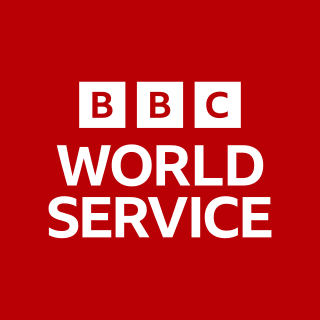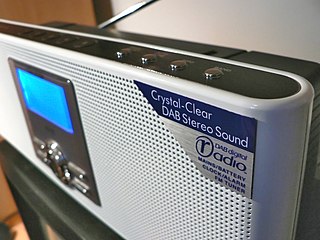Country Code: +1284
International Call Prefix: 011
Telecommunications in Namibia include radio, television, fixed and mobile telephones, and the Internet.

The BBC World Service is an international broadcaster owned and operated by the BBC. It is the world's largest external broadcaster in terms of reception area, language selection and audience reach. It broadcasts radio news, speech and discussions in more than 40 languages to many parts of the world on analogue and digital shortwave platforms, internet streaming, podcasting, satellite, DAB, FM and MW relays. In 2015, the World Service reached an average of 210 million people a week. In November 2016, the BBC announced that it would start broadcasting in additional languages including Amharic and Igbo, in its biggest expansion since the 1940s.

Shortwave radio is radio transmission using shortwave (SW) radio frequencies. There is no official definition of the band, but the range always includes all of the high frequency band (HF), which extends from 3 to 30 MHz ; above the medium frequency band (MF), to the bottom of the VHF band.
International broadcasting, in a limited extent, began during World War I, when German and British stations broadcast press communiqués using Morse code. With the severing of Germany's undersea cables, the wireless telegraph station in Nauen was the country's sole means of long-distance communication.
A numbers station is a shortwave radio station characterized by broadcasts of formatted numbers, which are believed to be addressed to intelligence officers operating in foreign countries. Most identified stations use speech synthesis to vocalize numbers, although digital modes such as phase-shift keying and frequency-shift keying, as well as Morse code transmissions, are not uncommon. Most stations have set time schedules, or schedule patterns; however, some have no discernible pattern and broadcast at unpredictable times. Stations may have set frequencies in the high-frequency band.
RTÉ Radio 1 is an Irish national radio station owned and operated by RTÉ and is the direct descendant of Dublin radio station 2RN, which began broadcasting on a regular basis on 1 January 1926.
Radiofacsimile, radiofax or HF fax is an analogue mode for transmitting monochrome images via high frequency (HF) radio waves. It was the predecessor to slow-scan television (SSTV). It was the primary method of sending photographs from remote sites from the 1930s to the early 1970s. It is still in limited use for transmitting weather charts and information to ships at sea.
Pirate radio in Ireland has had a long history, with hundreds of pirate radio stations having operated within the country.

Shortwave listening, or SWLing, is the hobby of listening to shortwave radio broadcasts located on frequencies between 1700 kHz and 30 MHz. Listeners range from casual users seeking international news and entertainment programming, to hobbyists immersed in the technical aspects of radio reception and collecting official confirmations that document their reception of distant broadcasts (DXing). In some developing countries, shortwave listening enables remote communities to obtain regional programming traditionally provided by local medium wave AM broadcasters. In 2002, the number of households that were capable of shortwave listening was estimated to be in the hundreds of millions.
HCJB, "The Voice of the Andes", was the first radio station with daily programming in Ecuador and the first Christian missionary radio station in the world. The station was founded in 1931 by Clarence W. Jones, Reuben Larson, and D. Stuart Clark. HCJB now focuses on Ecuador with unified programming on FM at 89.3 MHz in Pichincha, at 92.5 MHz in Manabí, at 96.1 MHz in Tungurahua and Cotopaxi, at 98.3 MHz in Esmeraldas and with separate programming on AM at 690 kHz. Broadcasts in Spanish and indigenous languages on 6.05 MHz (1 kW), continue on an intermittent basis with a new solid state transmitter which in 2017 replaced an older (5 kW) transmitter. These broadcasts were not listed on the HCJB English website as of February 2016.
The term utility station is used to describe fixed radio broadcasters disseminating signals that are not intended for reception by the general public. Utility stations, as the name suggests, do broadcast signals that have an immediate practical use, by means of analog or usually digital modes; most often utility transmissions are of a "point-to-point" nature, intended for a specific receiving station. Utility stations are most prevalent on shortwave frequencies, though they are not restricted to the shortwave frequencies.

CINW was the final call sign used by an English language AM radio station in Montreal, Quebec, which, along with French-language sister station CINF, ceased operations at 7:00 p.m. ET on January 29, 2010. Owned and operated by Corus Quebec, it broadcast on 940 kHz with a full-time power of 50,000 watts as a clear channel, Class A station, using a slightly directional antenna designed to improve reception in downtown Montreal.
Radio Luxembourg was a multilingual commercial broadcaster in Luxembourg. It is known in most non-English languages as RTL.

In the United Kingdom, the roll-out of digital radio has been proceeding since engineering test transmissions were started by the BBC in 1990 followed by a public launch in September 1995. The UK currently has one of the world's biggest digital radio networks, with about 500 transmitters, three national DAB ensembles, one regional DAB ensemble, 48 local DAB ensembles and an increasing number of small-scale DAB ensembles broadcasting over 250 commercial and 34 BBC radio stations across the UK. In London there are already more than 100 different digital stations available. In addition to DAB and DAB+, radio stations are also broadcast on digital television platform as well as internet radio in the UK. Digital radio ensemble operators and stations need a broadcasting licence from the UK's media regulator Ofcom to broadcast.
CKMX was a radio station broadcasting at 1060 AM in Calgary, Alberta, and owned by Bell Media. Its comedy format was branded on-air as Funny 1060. CKMX's studios were located in the CTV Calgary Studios on Patina Rise SW in the Prominence Point neighborhood of Calgary, and its transmitter site near Southeast Calgary. At night, CKMX could be heard as far west as Battle Ground and Snohomish, Washington. It could also be heard on shortwave on 6.03 MHz via its repeater CFVP, reaching western North America.
The British Broadcasting Corporation (BBC) is a British public service broadcaster headquartered at the Broadcasting House in London, originally established in 1922 as the British Broadcasting Company and evolved into its current state with its current name on New Year's Day 1927. The oldest and largest local and global broadcaster by stature and by number of employees, it employs over 21,000 staff in total, of whom approximately 17,900 are in public-sector broadcasting.

Radio in Argentina is an important facet of the nation's media and culture. Radio, which was first broadcast in Argentina in 1920, has been widely enjoyed in Argentina since the 1930s. Radio broadcast stations totaled around 150 active AM stations, 1,150 FM stations, and 6 registered shortwave transmitters. An estimated 24 million receivers were in use in 2000.
Broadcast call signs are call signs assigned as unique identifiers to radio stations and television stations. While broadcast radio stations will often brand themselves with plain-text names, identities such as "cool FM", "rock 105" or "the ABC network" are not globally unique. Another station in another city or country may have a similar brand, and the name of a broadcast station for legal purposes is normally its internationally recognised ITU call sign. Some common conventions are followed around the world.





